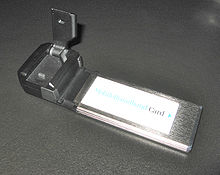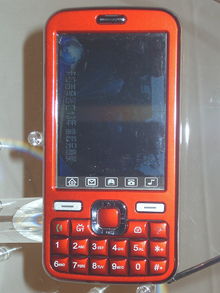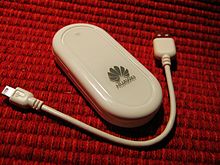- Mobile broadband
-

Mobile broadband is the marketing term for wireless Internet access through a portable modem, mobile phone (called "cell phones" in North America and South Africa) or other mobile device.
Contents
Description
Although broadband has a technical meaning, the phrase "mobile broadband" is a wireless carrier marketing term for Internet access. Bit rates of broadband support voice and video as well as other data access.[1]:3 Devices that provide mobile broadband to mobile computers include: PC cards also known as PC data card or Connect cards, USB modems, USB sticks often called "dongles", and portable devices with built-in support for mobile broadband (like notebooks, netbooks and Mobile Internet Devices. Notebooks with built-in mobile broadband modules are offered by many laptop manufacturers.
The GSM Association of telecommunication manufacturers, mobile phone producers, integrated circuit manufacturers and notebook manufacturers have joined forces to push built-in support for mobile broadband technology on notebook computers.[2] The association established a service mark to identify devices that include Internet connectivity with devices not usually associated with it.[2]
North America refers to mobile phones as cell phones. However all non-satellite mobile access technologies are cellular designs, but only CDMA-1 (EVDO related), GSM (GPRS/EDGE), UMTS/WCDMA/3G/FOMA/T-CDMA (HSPDA, HSUPA, HSPA, HSPA+) were originally intended for voice telephone calls. LTE and Mobile WiMax are data only, using VOIP for voice. Flash-OFDMA, IPW (derived from CDMA) and iBurst are also Data only networks. In theory also you could have an ERAN based EDGE2 network with no GPRS or GSM voice. Voice and SMS pays for the mobile phone networks.
Various network standards may be used, such as GPRS, 3G, WiMAX, LTE, Flash-OFDM, IPW, iBurst UMTS/HSPA, EV-DO and some portable satellite-based systems.[1] However mostly the term refers to EVDO (sister system to CDMA-1), EDGE on GSM and HSPDA/HSUPA/HSPA on UMTS/3G/Foma. Such systems piggyback on the mobile phone infrastructure (EDGE, HSPA etc. actually share spectrum with voice calls, which have priority). The actual "non-Mobile Phone" Mobile networks are very small subscriber base (Mobile WiMax, iBurst, Flash-OFDMA, IPW and portable Satellite terminals) compared to fixed wireless broadband. A common vendor tactic is to quote the peak speed for the entire channel. This capacity can be shared among other users, or limited in other ways as the network becomes more popular.[3]
Development
In 2002, the Institute of Electrical and Electronics Engineers (IEEE) established a Mobile Broadband Wireless Access (MBWA) working group.[4] They developed the IEEE 802.20 standard in 2008, with amendments in 2010.[5] Another working group, IEEE 802.16, produced standards adopted in products using the WiMAX trademark.[6]
A barrier to mobile broadband was the coverage the mobile phone networks can provide. In many areas customers will not be able to achieve the speeds advertised due to mobile data coverage limitations. In addition, there are issues with connectivity, network capacity, application quality, and mobile network operators' overall inexperience with data traffic.[7]
Demand from emerging markets fueled growth in mobile broadband . Without a widespread fixed line infrastructure, many emerging markets leapfrog developed markets and use mobile broadband technologies to deliver high-speed internet access to the mass market.
The global Third Generation Partnership Project (3GPP) family of standards - which includes GSM, EDGE, WCDMA, HSPA and LTE – is the most widespread way to deliver mobile broadband. 3GPP standards are serving about 90 percent of the world’s mobile subscribers.[citation needed]
After mobile broadband subscribers hit 500 million in 2010, at the end of 2011 Ericsson predicted it will be doubled to a billion. 400 million come from Asia Pacific region, followed by North America and Western Europe with more than 200 million subscriptions each.[8]
Ireland
In 2009 3 Ireland (part of Hutchison Whampoa) started an add-on roll out of their 3G/HSPA Mobile Phone service Marketed as Broadband and with the contract to supply the NBS. This is regarded as a catastrophe for prospective Broadband users.[9]
United Kingdom
In October 2008, a steering group known as Digital Britain was set up, with the aim of promoting digital telecommunications in the United Kingdom. The conclusion of the steering group was a recommendation that the government took up, namely to have 100% broadband coverage, with a minimum speed of 2Mbps in the United Kingdom by the year 2012. Mobile "broadband" using 3G is not now expected to be able to ensure 2Mbit/s broadband coverage to the more remote areas of the UK as coverage is too poor and contention too high. Another suggestion is Ka Satellite for Rural areas, which may be very cheap by the end of 2010 if Eutelsat's KA-SAT is successfully launched. There is also a smaller Ka Sat in 2010 from Avanti. However Satellite latency is about 790ms.
Types of devices used
- PDA
- smartphone, Mobile phone
- USB flash drive, (dongle)
- Compact Flash
- PC Card, ExpressCard
- SDIO
- MiFi
Service providers
There are competing common carriers in most nations. Some of these cellular networks and the carrier's service plans are:
North America
- Canada providers
- United States providers
- T-Mobile USA
- AT&T Mobility
- Verizon Wireless
- Sprint Nextel
- US Cellular
- Cricket Communications
- MetroPCS Wireless, Inc.
- Virgin Mobile
- Simple Mobile
- Clearwire provides wireless internet but not mobile phone service
- Mexico providers
Oceania
- Australia providers
- Telstra
- Optus
- 3 Mobile
- Virgin Mobile
- Vodafone
- New Zealand providers
Africa
- South Africa providers
- Zimbabwe providers
Europe
- Belgian providers:
- Bulgaria providers:
- Czech
- Danish providers:
- Finnish providers:
- DNA Oy
- Elisa Oyj
- Saunalahti
- Sonera
- Vodafone
- German providers
- Ireland providers
- O2 (Ireland)
- Vodafone Ireland
- 3 (telecommunications)
- Meteor (mobile network)
- Portuguese providers
- Slovakia providers
- Orange (brand)
- Telefonica O2
- T-Mobile
- Spanish providers:
- Swedish providers:
- United Kingdom providers
- United Kingdom Ofcom accredited impartial comparison service for broadband
- Simplifydigital
Asia
- Korea providers
- Pakistan providers
- Japanese providers:
- Indian providers:
- MTNL
- BSNL
- VSNL
- Airtel
- Aircel
- Idea Cellular
- Loop Mobile
- MTS India
- Vodafone Essar
- Tata Indicom
- Tata Docomo
- Tikona Digital Networks
- Reliance Mobile
- Spice Telecom
- S Tel
- Virgin Mobile India
- Videocon Mobile Service
- Uninor
- Indonesian providers
- Israeli providers
- P.R.China providers
- Filipino providers:
- Globe Tattoo(Globe Telecom)
- Smart Bro(Smart Communications/PLDT)
- Sun Cellular/Digitel
- Malaysia providers
- Singapore providers
- Sri Lanka Providers
Device manufacturers
- ZTE Corporation
- Cherry Mobile
- Danger
- Freewave Technologies
- HTC Corporation
- Hewlett Packard (HP)
- Huawei
- LG Electronics
- Motorola
- Nokia
- Novatel Wireless
- Option N.V.
- Panasonic
- Research In Motion (BlackBerry)
- Samsung
- Sierra Wireless
- Sony Ericsson
- Telit
- Tekelec
- Qualcomm
Technologies
- GPRS (2.5G)
- CDPD
- CDMA2000
- EDGE
- UMTS (3G)
- GPRS Core Network
- IP Multimedia Subsystem
See also
- Tethering
- mobile modem
- wireless modem
- Netbook
- Laptop
- Connect card
References
- ^ a b Mustafa Ergen (2009). Mobile Broadband: including WiMAX and LTE. Springer Science+Business Media. ISBN 978-0-387-68189-4. http://www.springerlink.com/content/978-0-387-68189-4.
- ^ a b "Service mark: The global technology identifer". GSM Association. http://www.gsmworld.com/our-work/mobile_broadband/service_mark/index.htm. Retrieved July 17, 2011.
- ^ "Is Mobile "midband" in Ireland Destroying broadband Infrastructure?". Ireland Offline opinion piece. August 29, 2009. http://irelandoffline.org/2009/08/is-mobile-midband-in-ireland-destroying-broadband-infrastructure/. Retrieved July 17, 2011.
- ^ "IEEE 802.20 Mobile Broadband Wireless Access (MBWA)". Working group web site. http://ieee802.org/20/. Retrieved July 16, 2011.
- ^ "IEEE 802.20 Mobile Broadband Wireless Access (MBWA)". Official standard. IEEE Standards Association. http://standards.ieee.org/about/get/802/802.20.html. Retrieved July 16, 2011.
- ^ "IEEE Approves IEEE 802.16m - Advanced Mobile Broadband Wireless Standard". IEEE Standards Association. March 31, 2011. http://standards.ieee.org/news/2011/80216m.html. Retrieved June 16, 2011.
- ^ DPI and Mobile Broadband White Paper; http://www.thetanetworks.com/resources/white-papers
- ^ Mobile broadband subscriptions to bypass 1bn in 2011 http://www.siliconrepublic.com/comms/item/19891-mobile-broadband-subscripti/
- ^ Michael Watterson. "The Great Irish Broadband and NBS Scams". Watty Stuff blog. http://www.wattystuff.net/issues/mobile-and-nbs/. Retrieved July 17, 2011.
External links
Some Comparisons between Dialup (narrowband), Mobile (Midband) and true always on Broadband: [1] linking to OECD, FCC and Irish Government Definitions. Explanation as to why mobile performance is often 1/10 of the advertised speed, drops connections and may not connect [2] at all.
Cellular network standards 0G (radio telephones) 1G AMPS familyOther2G 3GPP2 familyAMPS familyOther2G transitional
(2.5G, 2.75G)3GPP2 familyOther3G (IMT-2000) 3GPP family3GPP2 family3G transitional
(3.5G, 3.75G, 3.9G)3GPP family3GPP2 familyIEEE family4G
(IMT-Advanced)3GPP familyIEEE family5G Research concept, not under formal developmentLinks Related articlesCellular networks · Mobile telephony · History · List of standards · Comparison of standards · Channel access methods · Spectral efficiency comparison table · Cellular frequencies · GSM frequency bands · UMTS frequency bands · Mobile broadband · NGMN Alliance · MIMOExternal linksCategories:- Broadband
- Telecommunications
Wikimedia Foundation. 2010.




